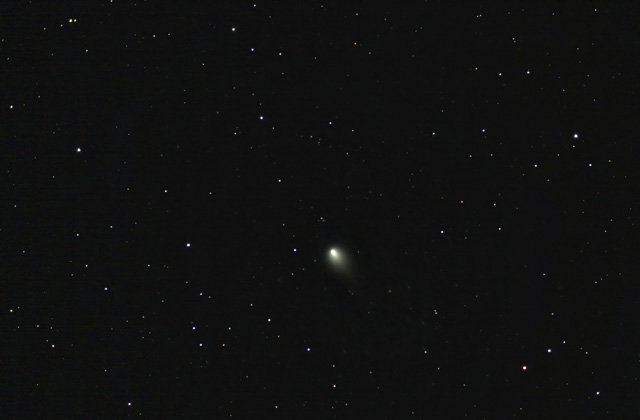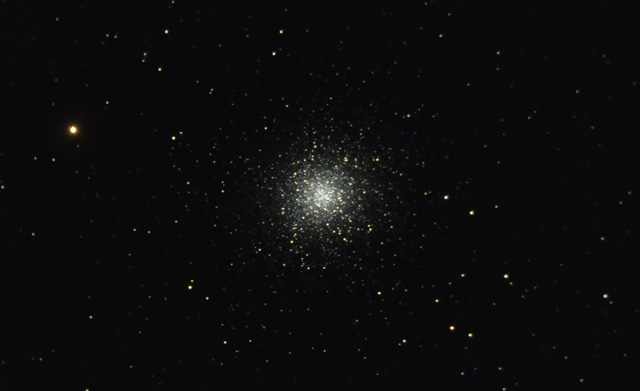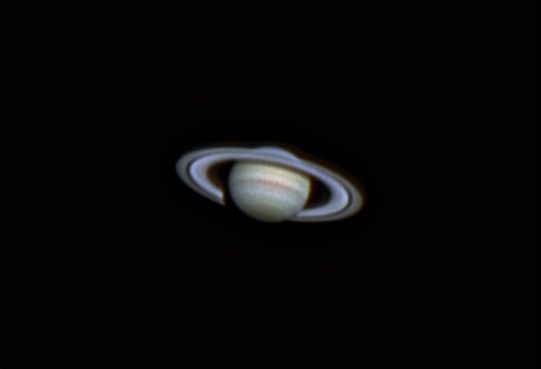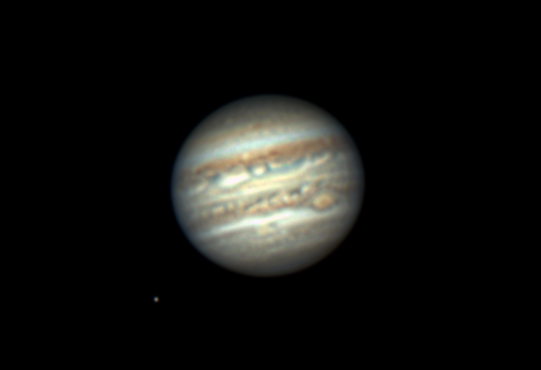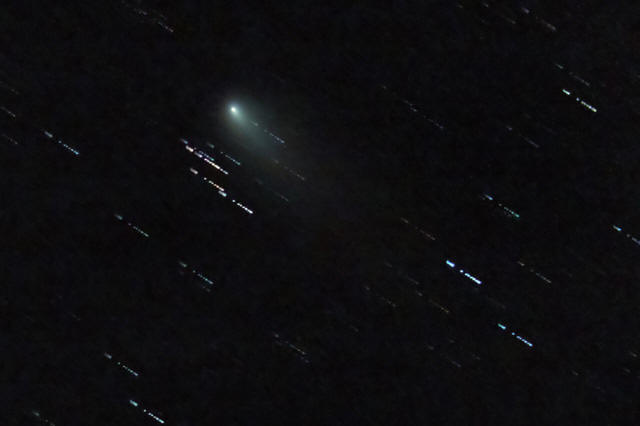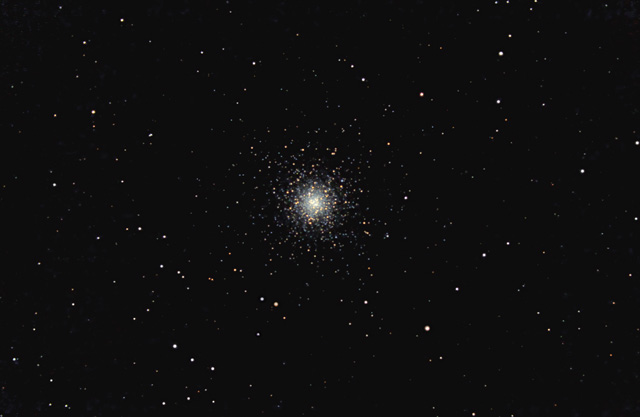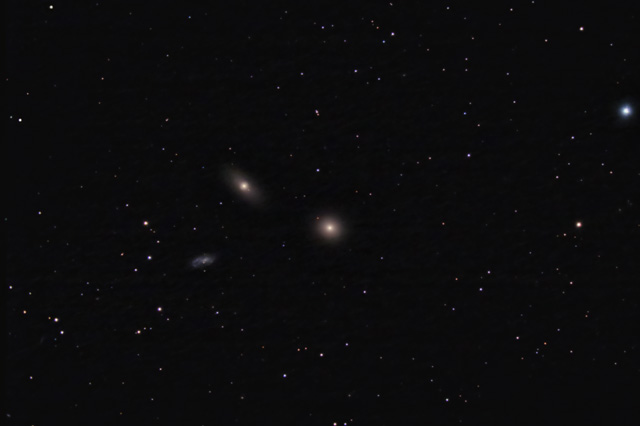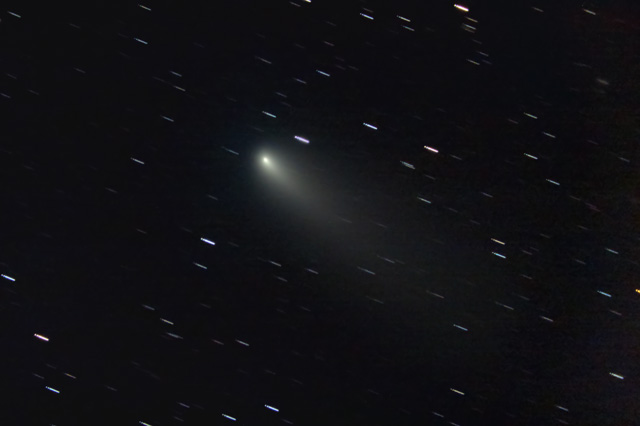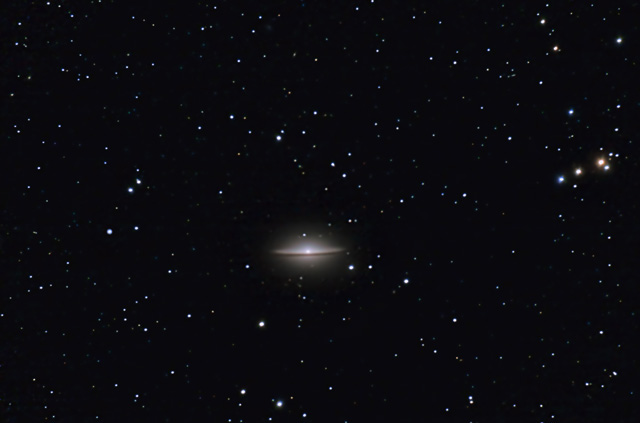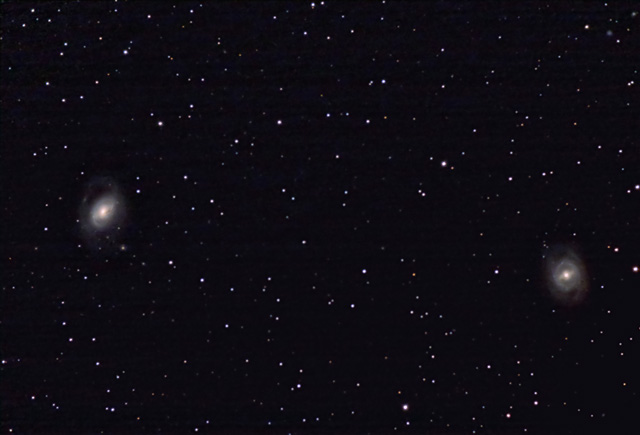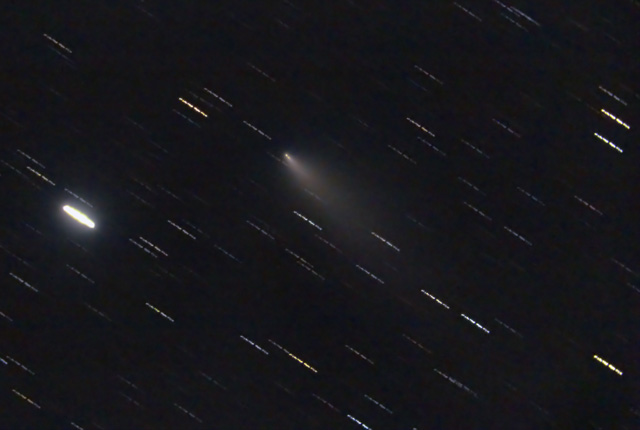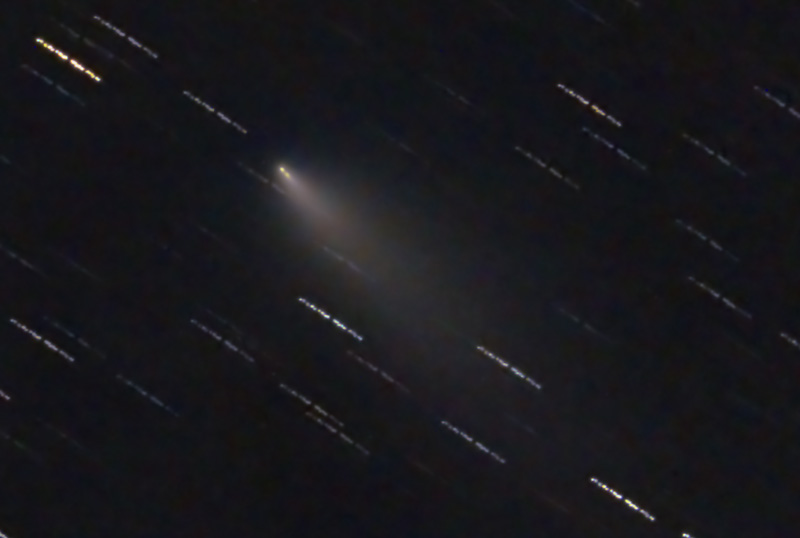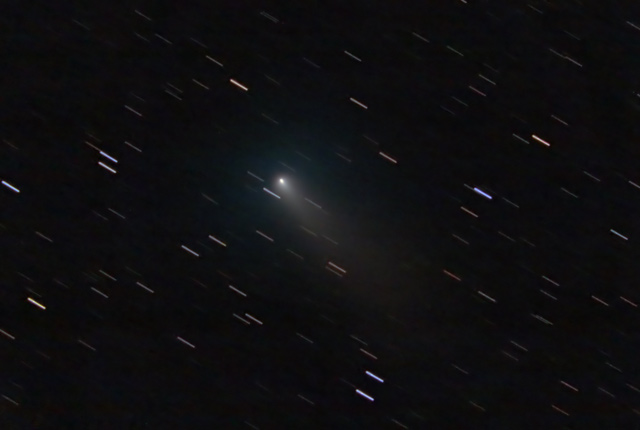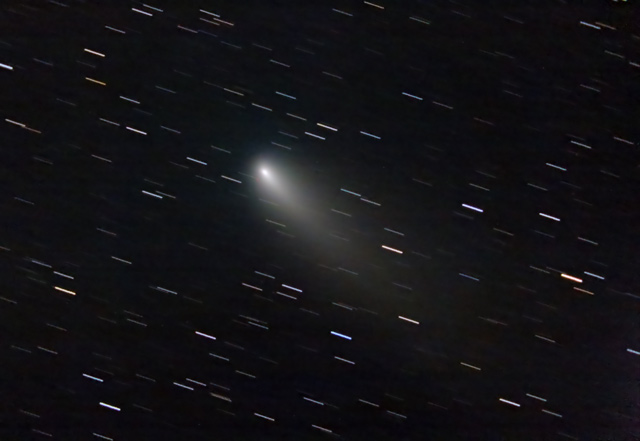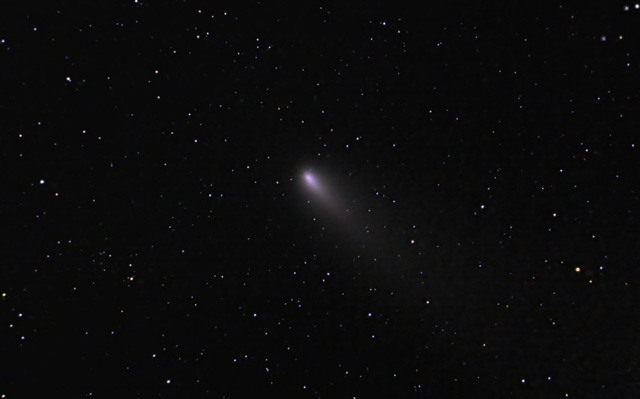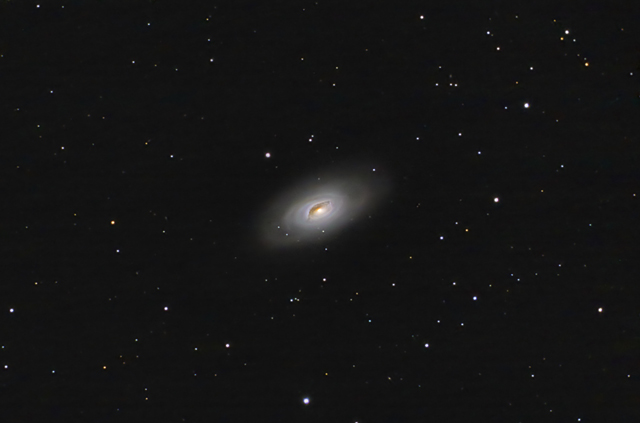______________________
Comet 73P/Schwassmann-Wachmann
|
Another comet is in the sky that is visible in binoculars and small telescopes. 73P/Schwassmann-Wachmann is now heading for a close pass by the Earth in May. It is visible in binoculars, or rather parts of it are. You see, this comet broke up back in the 90's and is now in many pieces. Each piece has the possibility for a photo-op as they all make their way toward perihelion. One piece will pass near M13 Globular cluster in early May. Another piece will pass very close to to M57, the Ring Nebula, also in May. For sure I'll be trying to image them next to these objects, but I know because of how fast they will be moving at this time, it will be difficult. |
|
Comet 73P/Schwassmann-Wachmann, component B on 4/9/06. Taken with a Celestron C-8 at F/6.3 (1260mm.) Guided with a Meade DSI and 100mm F/5 refractor. Camera is a Hutech Type 1 modified Canon 350 XT. Exposure was 40x60 second sub-images at 800 ISO. Processed and stacked in IRIS with dark, flat and bias calibration. Photoshop, RC-Astro's Gradient XTerminator and Noel Carboni's Astronomy Tools for post processing. Neat Image for noise reduction. This image was aligned on the stars and median stacked. Then, the alignment was done on the comet and the results of the previous stacking were combined.. Click here to see the full size hi-res version. |
______________________
M13 Globular Cluster on 4/10/06
|
My quest for a nice image of a better globular cluster continues. I choose M13 again to try and perfect my globular imaging technique. Most will say it takes layering short, medium and long exposures so that the full dynamic range of the object can be seen. Easier said than done! lol |
|
M13 on 4/10/06. Taken with a Celestron C-8 at F/6.3 (1260mm.) Guided with a Meade DSI and 100mm F/5 refractor. Camera was a Hutech Type 1 modified Canon 350 XT. Exposure was 1x150, 18x60 and 6x30 seconds sub-images, all at 1600 ISO. Processed and stacked in IRIS with dark, flat and bias calibration. Photoshop, RC-Astro's Gradient XTerminator and Noel Carboni's Astronomy Tools for post processing. Neat Image for noise reduction. Click here to see the full size hi-res version. |
______________________
Saturn and Jupiter on 4/15 & 4/16/06
|
With a full moon out, one of the best things to do is planetary observing or imaging, if the seeing permits it. It was not too bad on the night of April 14/15th, so I decided to try my luck. I did Jupiter again on the morning of the 16th, too. Here are the results: |
|
Saturn on 4/14/06. Taken with a Celestron C-8 , a 2X Barlow and a Toucam Pro in RAW mode. 503 frames acquired and stacked/sharpened in K3CCDTools. Post-processing in Photoshop with RC-Astro's Gradient XTerminator and Noel Carboni's Astronomy Tools. Neat Image for noise reduction. Richardson-Lucy deconvolution in IRIS. Click here to see the 2X enlarged version. |
|
Jupiter on 4/16/06. Taken with a Celestron C-8 , a 2X Barlow and a Toucam Pro in RAW mode. 400 frames acquired in K3CCDTools. Stacked in IRIS and wavelets, unsharp mask and Richardson-Lucy deconvolution applied. Post-processing in Photoshop. Click here to see the 2X enlarged version. |
______________________
Comet 73P/Schwassmann-Wachmann
On 4/19/06
|
Here is another image of the fast moving comet, 73/P Schwassmann-Wachmann. I had numerous clouds to contend with when I took the sub-images for this shot. At first I thought the night would be ruined. But, I managed to salvage enough good sub-images to generate the image below. Gaps in the star trails are the missing images that the clouds ate. LoL! Oh, well... I present what's left of it that the clouds didn't get: |
|
Comet 73/P-C Schwassmann-Wachmannon on the morning of 4/19/06. Taken with a Celestron C-8 at F/6.3 (1260mm.) Guided with a Meade DSI and 100mm F/5 refractor. Camera is a Hutech Type 1 modified Canon 350 XT. Exposure was 15x60 second sub-images at 1600 ISO. Processed and stacked in IRIS with dark, flat and bias calibration. Photoshop, RC-Astro's Gradient XTerminator and Noel Carboni's Astronomy Tools for post processing. Neat Image for noise reduction. This image was aligned on the comet's head. |
______________________
M53 Globular Cluster on 4/19/06
|
One of the many globular clusters that are in the sky that is visible right now is M53. It is an outlying globular, roughly 58,000 light-years from us and just a bit more than that from the galactic center. It is nicely packed, but not too dense in the center. |
|
M53 on 4/19/06 and 4/28/06. Taken with a Celestron C-8 at F/6.3 (1260mm.) Guided with a Meade DSI and 100mm F/5 refractor plus a 2x Barlow. Camera was a Hutech Type 1 modified Canon 350 XT. Exposure was 21x30 sec and 7x150 sec sub-images at 1600 ISO. Processed and stacked in IRIS with dark, flat and bias calibration. Photoshop, RC-Astro's Gradient XTerminator and Noel Carboni's Astronomy Tools for post processing. Neat Image for noise reduction. Click here to see the full size hi-res version. |
______________________
M105, NGC-3384 & NGC-3389
On 4/20/06
|
Leo has many galaxies that are easy to find. Here is a grouping of 3 galaxies with some smaller faint fuzzies visible in the background. The main galaxy here is M105, an elliptical galaxy with a huge black hole in it's center (50 million solar masses.) It is the bigger object on the right. To the left and above are NGC-3384 and the smaller galaxy is NGC-3389. |
|
M105, NGC-3384 & NGC-3389 on 4/20/06. Taken with a Celestron C-8 at F/6.3 (1260mm.) Guided with a Meade DSI and 100mm F/5 refractor plus a 2x Barlow. Camera was a Hutech Type 1 modified Canon 350 XT. Exposure was 15x150 seconds sub-images at 1600 ISO. Processed and stacked in IRIS with dark, flat and bias calibration. Photoshop, RC-Astro's Gradient XTerminator and Noel Carboni's Astronomy Tools for post processing. Neat Image for noise reduction. Click here to see the full size hi-res version. |
______________________
Comet 73P/Schwassmann-Wachmann
On 4/23/06
|
A clear night on April 22/23rd, 2006 let me image 73P/Schwassmann-Wachmann again. I used my C-8 at prime focus and did about 15 minutes worth of imaging for it. It could have used lots more time, but some high wispy clouds came in at about 2:00 am. and that cut my imaging session of it short. This is the main fragment of the comet. I also wanted to try and get an image of the "B" fragment, which is now in two pieces. (I guess they'll have to come up with a new letter for it. LoL!) Too bad the clouds did not want to leave when I asked. |
|
Comet 73P/Schwassmann-Wachmann, component C on 4/23/06. Taken with a Celestron C-8 at F/6.3 (1260mm.) Guided with a Meade DSI and 100mm F/5 refractor plus 2X Barlow. Camera is a Hutech Type 1 modified Canon 350 XT. Exposure was 14x60 second sub-images at 1600 ISO. Processed and stacked in IRIS with dark, flat and bias calibration. Photoshop, RC-Astro's Gradient XTerminator and Noel Carboni's Astronomy Tools for post processing. Neat Image for noise reduction. Click here to see the full size hi-res version. |
______________________
M104, The Sombrero Galaxy
On 4/23/06
|
You know, I've always wanted to image this galaxy. It is one of my favorite ones, but I hardly paid it any attention to it lately. That is about to change. Here is the first image of it, and there will be more because this one had a few problems and I want to try my hand again at it soon. |
|
M104 on 4/23/06. Taken with a Celestron C-8 at F/6.3 (1260mm.) Guided with a Meade DSI and 100mm F/5 refractor plus a 2x Barlow. Camera was a Hutech Type 1 modified Canon 350 XT. Exposure was 22x150 seconds sub-images at 1600 ISO. Processed and stacked in IRIS with dark, flat and bias calibration. Photoshop, RC-Astro's Gradient XTerminator and Noel Carboni's Astronomy Tools for post processing. Neat Image for noise reduction. Click here to see the full size hi-res version. |
______________________
M95 & M96 Galaxies
On 4/22/06
|
A pair of galaxies in Leo was my target that started the evening imaging session on Saturday night, April 22, 2006. I've been wanting to capture M95 & M96 together in an image. But , it looks like these guys could use lots and lots of exposure. This is only 55 minutes worth and it really needs more: |
|
M95 and M96 on 4/23/06. Taken with a Celestron C-8 at F/6.3 (1260mm.) Guided with a Meade DSI and 100mm F/5 refractor plus a 2x Barlow. Camera was a Hutech Type 1 modified Canon 350 XT. Exposure was 22x150 seconds sub-images at 1600 ISO. Processed and stacked in IRIS with dark, flat and bias calibration. Photoshop, RC-Astro's Gradient XTerminator and Noel Carboni's Astronomy Tools for post processing. Neat Image for noise reduction. Click here to see the full size hi-res version. |
______________________
Comet 73P/Schwassmann-Wachmann
Breakup of Fragment "B" Image 4/24/06
|
Exciting news about Comet 73P/Schwassmann-Wachmann was the observed breakup of fragment "B" over the last several days. I decided to try my luck at this small and dimmer fragment and see what it looks like. I managed to get an image of it from sub-images taken Sunday night/Monday morning. Below is a crop of the full frame image showing the comet next to a bright star. Below that are 2 enlargements showing the two "nuclei" or central condensations of the broken comet. Note the asymmetry of the second fragment relative to the first in the last image. Larger telescopes have confirmed that at the time my image was taken, the original B fragment was in at least 8 separate pieces. Two of those 8 were making up what looks the "2nd" fragment in my image with the rest scattered besides those two or trailing behind it. I also have a movie where the frames are composed of the images that made up the final image below. You can click here if you want to see it (7.57MB File.) |
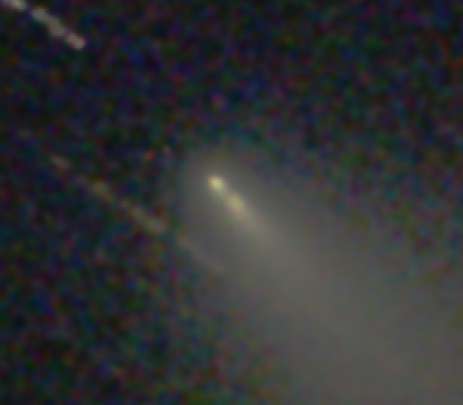
|
Comet 73P/Schwassmann-Wachmann, component B (now in two pieces) on 4/24/06. Taken with a Celestron C-8 at F/6.3 (1260mm.) Guided with a Meade DSI and 100mm F/5 refractor plus 2X Barlow. Camera is a Hutech Type 1 modified Canon 350 XT. Exposure was 27x60 second sub-images at 1600 ISO. Processed and stacked in IRIS with dark, flat and bias calibration. Photoshop, RC-Astro's Gradient XTerminator and Noel Carboni's Astronomy Tools for post processing. Neat Image for noise reduction. Click here to see the full size hi-res version. |
______________________
Follow-up on Comet 73P-B
Fragment Breakup on 4/28/06
|
Four days after taking the images with the two pseudo nuclei of Comet 73P-B/Schwassmann-Wachmann, I imaged this fragment again and the 2 nuclei were no longer there. The comet has brightened considerably, however. A glowing blue-green cloud of gases are all that is left of the many pieces that the fragment broke into, as far as I can tell: |
|
Comet 73P/Schwassmann-Wachmann, component B on 4/28/06, 0520 UT. Taken with a Celestron C-8 at F/6.3 (1260mm.) Guided with a Meade DSI and 100mm F/5 refractor plus 2X Barlow. Camera is a Hutech Type 1 modified Canon 350 XT. Exposure was 31x30 second sub-images at 1600 ISO. Processed and stacked in IRIS with dark, flat and bias calibration. Photoshop, RC-Astro's Gradient XTerminator and Noel Carboni's Astronomy Tools for post processing. Neat Image for noise reduction. Click here to see the full size hi-res version. |
______________________
Comet 73P-C/SW on 4/28/06
|
The bigger brother to our outbursting B component of Comet 73P/Schwassmann-Wachmann is fragment C, considered to be the main body of the comet. I imaged this fragment soon after the image of the B fragment above. It is still the bigger and brighter of the two and the one that promises to put on the best show. It is this piece that will fly near the Ring Nebula on May 7th, 2006. |
|
Comet 73P/Schwassmann-Wachmann, component C on 4/28/06, 0552 UT. Taken with a Celestron C-8 at F/6.3 (1260mm.) Guided with a Meade DSI and 100mm F/5 refractor plus 2X Barlow. Camera is a Hutech Type 1 modified Canon 350 XT. Exposure was 31x30 second sub-images at 1600 ISO. Processed and stacked in IRIS with dark, flat and bias calibration. Photoshop, RC-Astro's Gradient XTerminator and Noel Carboni's Astronomy Tools for post processing. Neat Image for noise reduction. Click here to see the full size hi-res version. |
______________________
The "Black Eye"
Galaxy
On 4/30/06
|
M64 is a larger spiral galaxy in Coma Berenices that has a nickname that is well deserved. Looking at the galaxy in a telescope with a south up orientation, the galaxy displays a dark band of material under a bright nucleus that gives the impression of an eye that has been blackened by a nice left hook. LoL. Since I usually display my images with a north up orientation, the effect is not as pronounced. Turn your head upside down if you want to see it. Heheh! |
|
M64, the "Black Eye" galaxy on 4/30/06. Taken with a Celestron C-8 at F/6.3 (1260mm.) Guided with a Meade DSI and 100mm F/5 refractor plus a 2x Barlow. Camera was a Hutech Type 1 modified Canon 350 XT. Exposure was 40x150 seconds sub-images at 1600 ISO. Processed and stacked in IRIS with dark, flat and bias calibration. Photoshop, RC-Astro's Gradient XTerminator and Noel Carboni's Astronomy Tools for post processing. Neat Image for noise reduction. Click here to see the full size hi-res version. |
